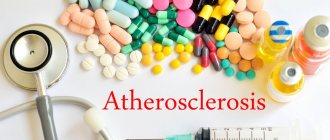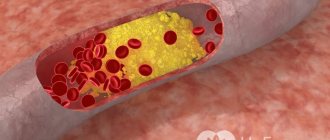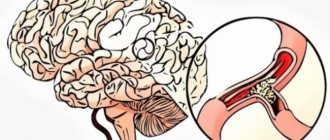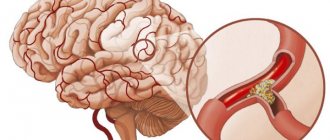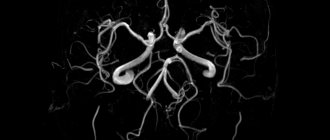Most people suffer from a number of diseases for simple reasons: unhealthy lifestyle and poor diet. Atherosclerosis of the neck vessels is one such disease. The name of the disease comes from two Greek words: atheros - fat and sclerosis - to close. Already knowing this, you can understand how important diet is when treatment of this disease with medications and folk remedies is prescribed.
The causes of atherosclerosis are quite varied. Symptoms of the disease develop from a combination of several factors. These include genetic predisposition, lifestyle errors, concomitant diseases, and features of nervous regulation. But regardless of the main reason that led to the appearance of signs of damage to the vascular bed of the cervical spine, diet for atherosclerosis of the vessels of the neck is one of the most important components of treatment.
What is the essence of the problem?
The idea that the composition of food affects human health appeared in the minds of people even before our era. Food is not only an essential source of proteins, fats and carbohydrates, but also a whole arsenal of components that do not carry a functional load, but are present in food as an inevitable “ballast”.
It is difficult to deal with such components once they have already entered the human body. It is not always possible to quickly neutralize them, neutralize them, or bring them out. In addition, such substances often play a dual role: positive, needed as a building material, and negative, expressed in the form of excess accumulations.
This directly concerns cholesterol, one of the controversial substances in the body . Being an essential part of the membranes of cellular structures, it promotes the synthesis of new tissue elements. Recognized as a precursor of corticosteroid and sex hormones, it is involved in the synthesis of bile acids, as well as such biologically important substances as vitamin D and others.
However, not all so simple. Certain fractions can cause significant harm to vascular health. When the physiological balance of lipoproteins of various classes is disturbed, a solid insoluble substance can be deposited on the walls of arteries and capillaries, reducing their lumen and creating serious obstacles to natural blood flow.
It is especially dangerous when lime-like deposits are concentrated in the vessels providing blood supply to the head. After all, a lack of blood supply to them means the risk of ischemic problems in areas of the brain with the likelihood of developing a heart attack of its vital structures.
The benefits of dietary supplements for atherosclerosis
Dietary supplements or complexes of dietary supplements are actively used to prevent cardiovascular diseases. They provide the body with vitamins, minerals, micro- and macroelements necessary for normal functioning.
Vitamins for atherosclerosis not only strengthen blood vessels and help regulate the functioning of the cardiovascular system, but are also natural antioxidants. Thus, vitamin C can reduce cholesterol in the blood, and in combination with bioflavonoids, it prevents vascular fragility.
Dihydroquercetin and other bioflavonoids reduce blood viscosity and improve the flow of oxygen to cells. Coenzyme Q10 is necessary for energy metabolism, and it also has membrane-stabilizing and antiarrhythmic effects. It is integrated into lipoproteins and prevents oxidative processes, which stops the progression of atherosclerosis. Many dietary supplements also contain important amino acids. Lysine prevents the deposition of lipoproteins on the walls of blood vessels and reduces the size of atherosclerotic plaques.
Ginkgo biloba extract contains ginkgolides, which reduce the risk of blood clots. The extract has vasodilating, antioxidant and antiarrhythmic properties, normalizes blood microcirculation in brain tissue, restores and strengthens the walls of blood vessels. Garlic extract reduces the production of cholesterol and lipids by liver cells, reduces blood clotting, reduces the risk of blood clots and blood sugar levels. Grape seed extract is rich in polyphenols, essential amino acids, vitamins and anthocyanins. It strengthens the walls of the arteries, increases their elasticity and improves blood flow.
Regular use of dietary supplements allows you to:
- reduce the risk of developing hypertension;
- prevent the development of varicose veins;
- increase physical and psycho-emotional endurance;
- improve overall well-being.
The use of dietary supplements is possible only after consultation with a doctor. They are usually taken in courses, three times a day during or after meals.
How to help the body?
Ischemic problems of the brain caused by errors in cerebral circulation are corrected with special medications. They are prescribed by a specialist, taking into account the individual characteristics of each case. However, the set of foods that a person eats is of no small importance.
In this case, the following matters: the chemical composition of raw food products, its changes under certain methods of preparation, digestibility characteristics, interaction with other products, mode of administration, quantity, degree of freshness and a number of other factors, including even information about the place of growth and time of harvest.
Adjusting the balance so that the body has time to take the necessary and safe part from the incoming diet is the number one task of modern dietetics in general and the prevention of vascular atherosclerosis in particular.
Recipes
Vegetable soup with pearl barley
You will need:
- Vegetable decoction, 325 g.
- Potatoes, 1 pc.
- Turnip and parsley root - 10 g each.
- Carrots, pearl barley, sour cream – 15 g.
- Tomatoes 20 g.
- Melted butter 10 g.
Leave the washed cereal soaked in water for 2 hours, strain, cook for 1 hour. Roughly chop the vegetables. Pour boiling water over the semi-finished pearl barley again, boil for 40 minutes, throw in the vegetables and continue cooking until they are soft. Add sour cream to the finished dish.
Zucchini stuffed with apples and carrots
Required ingredients:
- 2 medium zucchini, carrots and apple.
- 2 tbsp. l. butter.
- 4 spoons of sour cream.
- Some milk.
Remove the peel and core from the zucchini. Peel the root vegetable and grate it on a fine grater, simmer in milk until soft. Peeled, seedless apples are grated and mixed with stewed carrots. Green “boats” are stuffed with the mixture and placed in a row in a pan with fat. Simmer over low heat, covered, until soft; if desired, add sour cream when serving.
Puree with zucchini and meat
To prepare the dish you need:
- Low-fat beef or chicken breast, 150 g.
- Medium-sized young zucchini, 3 pcs.
- One chicken egg.
- Milk 2.5% 50 ml (1/4 cup).
- Oil drained 1 tbsp. l.
Grind the pre-cooked meat into minced meat, add water and simmer until soft. Cut the peeled and seeded vegetables into pieces and place in a saucepan. Boil in a small amount of liquid, keeping an eye on the time. Rub through a sieve and process for 5 minutes. Stir the egg yolk into milk and pour into the meat. Mix, keep on fire for several minutes, mix with the zucchini part.
What are the characteristics of such a diet?
When creating an appropriate diet, your doctor will always draw your attention to a set of foods that contain the maximum amount of cholesterol. These are: fatty meat, trans fats (for example, margarine), broths, high-fat pates, fried potatoes, brains, kidneys, mayonnaise, sweets, smoked lard, butter, milk and high-fat cottage cheese, as well as products prepared on their basis.
Having compiled a menu half consisting of such products and their components, the body is doomed to solve the question: what to do with them? where and how to dispose of them? Without finding an answer, after prolonged circulation in the bloodstream, cholesterol is deposited on its walls.
Legumes, vegetables, fruits, and oatmeal can help remove it and at the same time cleanse tissues of harmful substances. They contain soluble fiber, which helps remove harmful LDL (low-density lipoprotein).
The inclusion of products containing plant sterols is beneficial. They interfere with the absorption of cholesterol. These are fruits and greens, cereals, vegetable oils, beans. We can give an example of processed products. These are yoghurts and juices. Data have been published that if 2 g of such plant sterols are consumed once a day, this reduces cholesterol by one tenth of a percent.
Particular attention is given to products containing Omega-3 polyunsaturated acid , it is healthy and “smart”. On the one hand, it allows you to reduce blood pressure, on the other hand, it is characterized by the selectivity of its action. If at some point in time LDL decreases, HDL (high-density lipoprotein) concentrations, thanks to Omega-3, will increase. Products containing the following components: nuts, flax seeds, fatty sea fish (mackerel, herring, salmon).
It is better if there are at least 200g of these products daily.
Nutrition rules for atherosclerotic vascular disease
Atherosclerosis is a disease characterized by the deposition of cholesterol plaques on the inner walls of blood vessels. The main factors that provoke the accumulation of cholesterol and other fats are:
- unbalanced diet, including a large number of foods high in animal fats;
- lipid metabolism disorder;
- excess weight;
- sedentary lifestyle;
- arterial hypertension and other heart diseases;
- diabetes;
- negative psychological climate, frequent stress, emotional fatigue;
- chronic renal failure, liver cirrhosis and other chronic diseases;
- age and hereditary predisposition;
- bad habits.
The cause of atherosclerosis is poor nutrition.
Treatment involves drug therapy, lifestyle changes and a constant diet. Nutrition for atherosclerotic vascular lesions is selected in such a way as to reduce the amount of anti-atherogenic lipoproteins in the blood and increase the amount of high-density lipoproteins. Constant adherence to an anti-cholesterol diet also helps to reduce bad cholesterol and improve the condition of blood vessels.
Organization of the daily diet
Nutritional principles for patients with atherosclerosis include:
- restriction or exclusion from the diet of foods that increase the level of low or very low density lipoproteins in the blood;
- determination of the maximum daily amount of cholesterol consumed (no more than 200 mg per day);
- reducing daily caloric intake;
- reduction or elimination of animal fats;
- reducing the volume of refined vegetable oil in the daily diet;
- reducing the amount of salt and spices, as well as adding salt to the finished dish;
- avoiding large amounts of sugar;
- determination of the minimum daily serving of proteins (from 150 g);
- introduction to the menu of a large number of foods rich in fiber, vitamins, microelements, amino acids.
When organizing nutrition for vascular atherosclerosis, you should also consider:
- balanced diet. Nutrition is aimed at improving the functioning of the heart, blood vessels, metabolic processes and reducing the risk of complications;
- need for weight loss. For obesity, the maximum daily caloric intake is calculated together with a nutritionist;
- menu composition. The predominance of vegetables and fruits in your diet will not only help you lose weight, but also improve your overall condition.
Attention must be paid to the correct combination of fats of plant and animal origin. Vegetable fats should account for more than 50% of the total volume. When increasing the amount of plant foods, it is recommended to include soy. It is especially useful for its chemical composition, physical properties and ability to replace meat. Constant consumption of soy leads to stabilization of lipid metabolism, improvement of blood composition and normalization of well-being.
Vitamins for atherosclerosis are necessary to maintain the functioning of the cardiovascular system, regulate sugar and cholesterol levels, and normal functioning of the body. They should be present in their natural form (in products) in the daily menu. The lack of vitamins of one group or another is compensated for by taking multivitamin complexes after a blood test and consultation with a doctor.
Diet
For atherosclerosis, the diet is made taking into account:
- time and amount of food taken;
- duration of intervals between meals;
- the value and chemical composition of the diet;
- volume and range of products.
Doctors recommend that when drawing up a menu, you should proceed from the following rules:
- amount of daily portion of salt - up to 8 g;
- the amount of daily portion of carbohydrates is no more than 400 g;
- the amount of daily portion of fat is up to 70 g for normal weight;
- the amount of protein at normal weight is calculated based on 1.5 microns per 1 kg of weight.
To make it more convenient to calculate calorie content, all products for atherosclerosis are divided into 5 groups. The first category includes foods with high calorie content (more than 450 kcal per 100 g). These are vegetable and butter, chocolate, baked goods, nuts, fatty meats, sausages, and cheeses. The second group includes products with moderate calorie content (from 200 to 450 kcal): duck and goose meat, sour cream and cream, caviar, pasta, cereals, bread, jam, etc. The third group includes products with reduced moderate calorie content (from 100 to 200 kcal). These are veal, chicken and rabbit meat, low-fat cottage cheese, fatty fish (sturgeon, mackerel), etc. The fourth group contains low-calorie foods (less than 100 kcal and more than 30 kcal per 100 g). These include low-fat dairy products, some types of fish (hake, cod, pike perch), most fruits, vegetables and berries. The last group includes products containing less than 30 kcal (sweet peppers, cabbage, celery, lettuce, turnips, pumpkin, fresh mushrooms, cucumbers, spinach, asparagus, lingonberries, melon, peaches, green and onions, etc.).
How else can you enrich your food?
When forming a diet to combat and prevent vascular atherosclerosis, it is necessary to provide for the presence in the diet of:
- lecithin-containing products (chicken egg yolk, liver, peas, beef, yeast, buckwheat, fish roe, oatmeal and others);
- vitamin C (citrus fruits, apples);
- honey and honey products;
- jams, jellies;
- green fruits, as well as parsley, dill, green salad, celery;
- baked products from fish, meat (without salt);
- grain bread, preferably with the addition of rye or oat bran.
Nutritionist opinion
According to nutritionists, by following the above recommendations regarding nutrition, already in the first month you can observe a noticeable improvement in your condition - at the level of biochemical tests.
Nutritionists advise:
- season salads with vegetable oils, especially leaning on flaxseed and olive oils;
- remove “bad” cholesterol by introducing bran into the diet;
- drink only weak tea and coffee, and in limited quantities;
- create a diet based on diet No. 10 (cholesterol-free diet), under the guidance of your doctor and nutritionist.
If the diagnosis of ANC has already been made, then the diet becomes lifelong. Violations are permissible a maximum of 1-2 times a year - if there is no deterioration, and pain in the legs does not appear after relaxation in the diet.
How to cook healthy meals?
Vegetables are recommended to be consumed both raw and boiled. If salads are preferred, the ingredients for them should be chopped as little as possible, or you can resort to grating. If the vegetables are cooked, you can add a little butter to them without any problems. If the dish contains a raw vegetable component, it would be correct to season it with vegetable oil.
Salads containing seafood, as well as those based on soaked herring, dietary low-fat ham or boiled fish, are especially valuable. Thus, you can treat yourself to delicious, healthy cold appetizers.
Sea kale is very useful. In addition to HDL, it contains a lot of useful iodine.
First courses are an essential part of the daily menu. Vegetable soups (zucchini, carrots, cabbage, potatoes, cauliflower, bell peppers, parsley and others), dairy, and fruit soups are healthy. When preparing soups, it is better not to use salt, as it retains fluid in the body.
If you need to make homemade noodles, only egg whites are used for the dough. Porridge and similar cereal products are extremely useful.
For those who love sauces, you can choose vegetable broths as a base for them, use tomatoes or season them with sour cream. While mayonnaise and horseradish are restricted, vanillin, citric acid and other similar components are not prohibited.
Fully or partially limited products
Products made from puff pastry and butter dough, meat, fish, and mushroom broths are completely excluded. You cannot eat fatty pork, cooking fats, duck, goose, kidneys, brains, liver, sausages, canned food and all kinds of smoked meats.
Fatty fish, canned fish and caviar, salted and smoked fish are prohibited. Do not eat fatty cheese and cream, cottage cheese and sour cream. The consumption of radishes, radishes, sorrel, spinach and mushrooms is prohibited. Chocolate, ice cream, and products with cream are not allowed. As for sauces, you should not use meat, fish, mushroom, or mustard. Strong tea and coffee, cocoa are prohibited.
Limit egg yolks, rice, semolina and pasta, mayonnaise, horseradish. For obesity - grapes, sugar, honey, raisins, jam are allowed rarely and in minimal quantities.
Table of prohibited products
| Proteins, g | Fats, g | Carbohydrates, g | Calories, kcal | |
Vegetables and greens | ||||
| radish | 1,2 | 0,1 | 3,4 | 19 |
| white radish | 1,4 | 0,0 | 4,1 | 21 |
| red radish | 1,2 | 0,1 | 3,4 | 20 |
| black radish | 1,9 | 0,2 | 6,7 | 35 |
| spinach | 2,9 | 0,3 | 2,0 | 22 |
| sorrel | 1,5 | 0,3 | 2,9 | 19 |
Fruits | ||||
| bananas | 1,5 | 0,2 | 21,8 | 95 |
Berries | ||||
| grape | 0,6 | 0,2 | 16,8 | 65 |
Mushrooms | ||||
| mushrooms | 3,5 | 2,0 | 2,5 | 30 |
Nuts and dried fruits | ||||
| raisin | 2,9 | 0,6 | 66,0 | 264 |
Cereals and porridges | ||||
| semolina | 10,3 | 1,0 | 73,3 | 328 |
| rice | 6,7 | 0,7 | 78,9 | 344 |
Flour and pasta | ||||
| pasta | 10,4 | 1,1 | 69,7 | 337 |
Confectionery | ||||
| jam | 0,3 | 0,2 | 63,0 | 263 |
| jam | 0,3 | 0,1 | 56,0 | 238 |
| candies | 4,3 | 19,8 | 67,5 | 453 |
| pastry cream | 0,2 | 26,0 | 16,5 | 300 |
| cookie | 7,5 | 11,8 | 74,9 | 417 |
Ice cream | ||||
| ice cream | 3,7 | 6,9 | 22,1 | 189 |
Cakes | ||||
| cake | 4,4 | 23,4 | 45,2 | 407 |
Chocolate | ||||
| chocolate | 5,4 | 35,3 | 56,5 | 544 |
Raw materials and seasonings | ||||
| mustard | 5,7 | 6,4 | 22,0 | 162 |
| mayonnaise | 2,4 | 67,0 | 3,9 | 627 |
Dairy | ||||
| milk 3.6% | 2,8 | 3,6 | 4,7 | 62 |
| milk 4.5% | 3,1 | 4,5 | 4,7 | 72 |
| cream | 2,8 | 20,0 | 3,7 | 205 |
| sour cream 25% (classic) | 2,6 | 25,0 | 2,5 | 248 |
Cheeses and cottage cheese | ||||
| cheese | 24,1 | 29,5 | 0,3 | 363 |
| cottage cheese 11% | 16,0 | 11,0 | 1,0 | 170 |
| cottage cheese 18% (fat) | 14,0 | 18,0 | 2,8 | 232 |
Meat products | ||||
| pork | 16,0 | 21,6 | 0,0 | 259 |
| pork liver | 18,8 | 3,6 | 0,0 | 108 |
| pork kidneys | 13,0 | 3,1 | 0,0 | 80 |
| pork fat | 1,4 | 92,8 | 0,0 | 841 |
| salo | 2,4 | 89,0 | 0,0 | 797 |
| beef liver | 17,4 | 3,1 | 0,0 | 98 |
| beef kidneys | 12,5 | 1,8 | 0,0 | 66 |
| beef brains | 9,5 | 9,5 | 0,0 | 124 |
Sausages | ||||
| smoked sausage | 16,2 | 44,6 | 0,0 | 466 |
| smoked sausage | 9,9 | 63,2 | 0,3 | 608 |
| sausages | 10,1 | 31,6 | 1,9 | 332 |
| sausages | 12,3 | 25,3 | 0,0 | 277 |
Bird | ||||
| smoked chicken | 27,5 | 8,2 | 0,0 | 184 |
| duck | 16,5 | 61,2 | 0,0 | 346 |
| smoked duck | 19,0 | 28,4 | 0,0 | 337 |
| goose | 16,1 | 33,3 | 0,0 | 364 |
Fish and seafood | ||||
| smoked fish | 26,8 | 9,9 | 0,0 | 196 |
| salted fish | 19,2 | 2,0 | 0,0 | 190 |
| Red caviar | 32,0 | 15,0 | 0,0 | 263 |
| black caviar | 28,0 | 9,7 | 0,0 | 203 |
| canned fish | 17,5 | 2,0 | 0,0 | 88 |
| cod (liver in oil) | 4,2 | 65,7 | 1,2 | 613 |
Oils and fats | ||||
| animal fat | 0,0 | 99,7 | 0,0 | 897 |
| cooking fat | 0,0 | 99,7 | 0,0 | 897 |
Non-alcoholic drinks | ||||
| instant coffee dry | 15,0 | 3,5 | 0,0 | 94 |
| black tea | 20,0 | 5,1 | 6,9 | 152 |
| * data is per 100 g of product | ||||
Is there a limit on drinks?
Those drinks whose taste is improved synthetically (with the addition of flavors, preservatives, taste improvers) have no practical health benefits. Carbonated artificial waters, on the contrary, will harm digestion.
Useful: rosehip-based decoctions, green tea (possibly with lemon), dried fruit compotes, vegetable juices, natural fruit drinks.
You need to be careful with freshly squeezed fruit juices, since the acids they contain can negatively affect the condition of the gastrointestinal mucosa (especially in people with a tendency to gastritis, peptic ulcers with high acidity).
For those who cannot imagine their life without a cup of coffee, it is recommended to drink a cup of weak coffee a day or replace it with a chicory drink.
Reviews and results
This diet is designed to last for a long time, as it is balanced and contains a variety of foods. Some restriction in carbohydrates and fats does not adversely affect health, but on the contrary allows you to lose weight, normalize cholesterol and feel good. All these points are noted in the reviews of patients.
- “...I improved my health and lost weight. I liked this healthy diet. True, I was also prescribed pills to lower cholesterol”;
- “... I’m happy with the results: cholesterol has decreased, sugar has normalized, and I’ve even lost weight. Beauty!";
- “...Cholesterol was not very high, so I managed only with therapeutic nutrition. I continue to eat like this”;
- “... My result is minus 5 kg, my general condition has improved significantly and my tests have become normal”;
- “... Helped me lose weight and improve my condition, but I think that the tests became normal thanks to the pills. I won’t push myself further and will eat right.”
- “... This is not even a diet, but proper nutrition. I see only benefits in low-fat dishes without frying or batter. I eat constantly, even though no one prescribed it for me. Cholesterol is normal."
What is the approximate recommended menu?
First option
First breakfast:
I. 100 g of boiled lean meat with vinaigrette, seasoned with vegetable oil;
II. chicory drink with low-fat milk.
Second breakfast: 200 g of seaweed and carrot salad.
Dinner:
I. vegetarian soup;
II. boiled fish with baked potatoes;
III. dried fruits compote.
Afternoon snack: a cup of green tea with oatmeal cookies.
Dinner:
I. cottage cheese casserole made from low-fat cottage cheese;
II. fresh fruit jelly.
Vascular lesions of the lower extremities: what products are mandatory for consumption?
When creating a diet for atherosclerosis with predominant damage to the arteries of the extremities, possible complications of this form of the disease are taken into account. Since the main problem (especially with damage to the blood vessels of the legs) is trophic disorders (non-healing ulcers, gangrene), the patient’s diet should be rich in foods that promote adequate blood supply to the tissues.
This list includes:
- Flavonoids (resveratrol, citrine, rutin, hesperidin, quercetin). These substances have truly amazing properties:
thin the blood; - maintain the elastic properties of the vascular wall;
- promote the disappearance of small blood clots;
- prevent the spread of atherosclerosis;
- resveratrol prevents the formation of blood clots in blood vessels (found in the skin of ripe grapes).
- Coumarins. The effect of these substances is to thin the blood and prevent blood clots. They are contained in parsley (another plus in favor of salads, most importantly - without mayonnaise), celery, horseradish root, chamomile flowers (instead of green tea, like herbal tea).
- Vitamin E. One of the actions is to strengthen the vascular wall. It also improves the rheological properties of blood (fluidity). Good sources of this substance are greens, nuts and seeds, and vegetable oils.
They are found in: fruits of cherries, sea buckthorn, cherries, plums, black currants, cranberries, hazelnuts, rose hips.
The diet prescribed for atherosclerosis of the vessels of the lower extremities is confidently used in cases of damage to the upper extremities.
